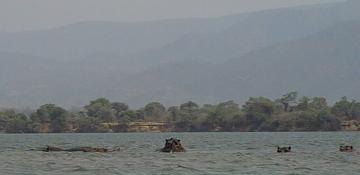
Western Zimbabwe
Our plans for Zimbabwe have always been purposely ill-formed. We knew that visiting Patty and Martin, our friends in Harare, would allow us ample opportunity to pick a local's brain and find the portions of Zimbabwe that were "unmissable." Two possible vacation routes became obvious: blast east towards the Moçambique border and tour the Eastern highlands to enjoy the pleasantly cool climate while the rest of Zimbabwe bakes and burns, or swing through the western half of the country to visit the big game parks and finish up with Victoria Falls. For us, the choice was easy: we were always heading west, with both Botswana and Namibia following our tour of Zimbabwe.
This doesn't mean we will miss the Eastern highlands; our ultimate goal is Kenya, and we had always planned to reach it by driving up the east coast of Africa. We may just hit Zim's Eastern highlands on the way north through Moçambique. As the border between Moçambique and its northern neighbor Tanzania is currently impassable by vehicle (there are no bridges or ferries across the river separating the two), a trip inland from the Moçambique coast was always necessary. Nothing to stop us from hitting Zim's east on the way up.
But the western swing alone wouldn't be quite enough. The Zambezi is a mysterious and powerful river, and to only see it at Victoria Falls wouldn't suffice. A taste of darkest Africa is needed, and Patty tells us that Mana Pools is the place to get it. So instead of heading southwest, we turn our Land Rover Spot the other way and detour towards the wild north.
Mana Pools
October 26th - October 29th, 1999
Our drive north from Harare turned out to be a beautiful one. The main highway we took north turned out to be what in America would be a county highway with little traffic and lots of lovely hills and curves. The road would have made for a fantastic motorcycle ride but for the African size bugs that caused even Spot to shudder upon impact. We really knew we were getting out there when we crossed the Tsetse fly road gate. The last eighty kilometers turned out to be on alternately sandy and rocky unpaved park roads, occasionally passing odd rolled over cars and trucks of those who tried to travel the road a bit too fast.
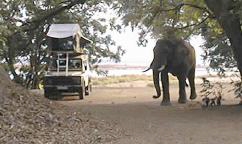 What we found was some of the wildest camping
either of us had ever seen. Whomever set up the camp grounds must have had
a streak of sadism, as one camped up right along the paths the animals used
to access the river. No fences or other impediments, no sirree. This allows
opportunities for many animals to fill the "squirrel niche"; that
is, the animal mostly likely to join you and the ants at picnic time. Most
memorable was our elephant visitation (pictured right). Ol' packie here
really wasn't too interested in our camp. He simply wandered up from another
camp, stared at Spot a bit, and then visited the next neighbor's camp. The
first neighbor was his favorite place -- there he would linger for up to
an hour at a time. Perhaps he smelled oranges -- they're the elephants'
chocolate.
What we found was some of the wildest camping
either of us had ever seen. Whomever set up the camp grounds must have had
a streak of sadism, as one camped up right along the paths the animals used
to access the river. No fences or other impediments, no sirree. This allows
opportunities for many animals to fill the "squirrel niche"; that
is, the animal mostly likely to join you and the ants at picnic time. Most
memorable was our elephant visitation (pictured right). Ol' packie here
really wasn't too interested in our camp. He simply wandered up from another
camp, stared at Spot a bit, and then visited the next neighbor's camp. The
first neighbor was his favorite place -- there he would linger for up to
an hour at a time. Perhaps he smelled oranges -- they're the elephants'
chocolate.
Harder to catch on camera were the impala. While shy and very wary of humans, eventually they would build up their courage and bolt through the campgrounds -- fifty at a time. While very fast, they must have not been too scared, as many would "pronk" as they ran through. That is, they would make these fantastic leaps in the air, seemingly suspended until they landed running once again. Pronking though, is not as fast as running and impala only do this when happy. Interestingly enough, we had never seen this before; Kruger impala never pronked for us.
Most annoying, though, were the baboons. Seems the qualities that makes a campsite attractive to people also attract baboons. They slept in some of trees over the campgrounds, and loved to make twice daily food raids on the human campers. One large male in particular has lost all fear of humans, and the only way to stop him was to physically threaten him. Usually we used our slingshots, but once he caught us off guard while we were making our morning's first cups of coffee, and Jim had to chase him wielding only a lawn chair. The baboons might be sacred to the locals here, but if Jim had caught him that little simian would gotten a taste of vinyl and tin.
While these animal side shows were nice, the main attraction at Mana Pools are the hippos. While none made any campsite visits, they would sing to each other during both night and day. Our first reactions were a "what's that?" sort of one, but we came to appreciate and enjoy the haunting and melodic hippo songs.
However, they weren't singing for us the day we went canoeing on the Zambezi. Usually when we did see them we got that dull, hippo stare that says "what the hell are you doing here?" We were trying to keep our distance, and despite the strong Zambezi current and the brisk winds that day we did stay out of the hippos' way. Only the big males stay above water and watch you; all the others just duck under water for a few minutes while we passed by.
Our admiration of Hippo music caused us some inconvenience one day. We
decided to take our lawn chairs down to the river's edge and watch and listen
to the hippos more closely. Upon our return, we found that the baboons and
their smaller cousins, the vervet monkeys, had wrought revenge upon us.
Perhaps they were angry that we were so effective at keeping them at bay
from some of their favorite trees, but whatever the reason they had used
Spot and our tent as a trampoline. We had tidied up and locked everything
away so nothing was missing, but the tent and its ladder were all askew.
One monkey had sent us an unmistakable message by shitting right upon the
tent top! We cleaned up quickly and from then on were quite cautious whenever
we left camp, ensuring that the tent and the truck were as secure as possible.
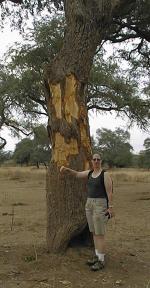 Unusual was that while we did see a few elephants up close,
we only saw a few. Mana Pools and Zimbabwe in general are straining underneath
an elephant population boom. Between the shrinking lands preserved for the
elephants and the exploding population, Zimbabwe estimates that it has over
twice as many elephants as their land can support. By the end of a winter's
dry season, most elephants are starving and lay waste to forests in their
struggles to find food. The damage they can cause is incredible, denuding
whole plains. Almost every tree has scars from elephants (see the photo
for an example).
Unusual was that while we did see a few elephants up close,
we only saw a few. Mana Pools and Zimbabwe in general are straining underneath
an elephant population boom. Between the shrinking lands preserved for the
elephants and the exploding population, Zimbabwe estimates that it has over
twice as many elephants as their land can support. By the end of a winter's
dry season, most elephants are starving and lay waste to forests in their
struggles to find food. The damage they can cause is incredible, denuding
whole plains. Almost every tree has scars from elephants (see the photo
for an example).
Hunting elephants in the national parks is illegal in Zimbabwe by international agreement, but we saw evidence of poaching going on still. Even more interesting is who does the poaching: park rangers. It's a well known but little discussed fact that while certain animals are off limits (rhinos, for example), the elephants are fair game for park rangers and their family. Ivory drives the impetus for park poaching. Yes, there is an oversupply of elephants but having park rangers illegally hunting them struck us as a bit disturbing. Almost as disturbing as coming upon them unawares with their fatigues and AK-47s.
Wild and woolly -- that's Mana Pools. They even let you walk around the
park if you wish (mind the lions and crocodiles, though). While camping
there is nice, the Zambezi current makes canoeing very difficult. Next time
we go we'll take part of one of those canoe excursions that drift down the
Zambezi, making a stop at Mana Pools but also allowing you to explore other
portions of the river.
Matobo
October 30th - November 1st, 1999
In Zimbabwe, people center their lives upon the land. There are places that they refer to as their source of power. Our next destination was one of those that sing to the hearts of all who've lived here: Matobo. Though it's the traditional homeland of the N'debele tribe, all Zimbabweans feel a connection to this place. Some really dig it; Patty and Martin are two. So much so that they decided they needed an extended weekend off from work-reality and decided to join us camping. So happens they have a close friend by the name of Tess who lives nearby in Bulawayo and is a certified Matobo junkie. Saturday night is our agreed meeting time and Tess' classic car parking lot apartment in Bulawayo is the agreed meeting place.

 Early Sunday morning we're all
off to the southern part of Matobo National park for a few days camping.
It's natural to see how someone could consider Matobo a place of power.
The terrain there can be best described as "ripples in the land."
Rolling and smooth, with the occasional oddly perched boulders, this rocky
land has long been considered by the N'debele to be a holy place.
Early Sunday morning we're all
off to the southern part of Matobo National park for a few days camping.
It's natural to see how someone could consider Matobo a place of power.
The terrain there can be best described as "ripples in the land."
Rolling and smooth, with the occasional oddly perched boulders, this rocky
land has long been considered by the N'debele to be a holy place.
Though the land has already seen the first few showers of spring, Matobo is still bone dry and quite arid. It's amazing how much manages to survive here. Our favorite turns out to be the climbing fig tree, which roots itself in the most precarious of rock faces and seemingly becomes one with the stone. To the right here you can see Martin and Tess discussing the fine details of this climbing fig and its differences from other similar tree. Tess turns out to be quite knowledgeable about the flora and fauna of her home country
To the left you can see how one of the first rocks
we climbed looked from the valley floor. With the vegetation so dry and
sparse, wildlife viewing was at its best and on our drive to our campgrounds
Kathy and Jim were lucky enough to catch of a family of rhinos. We had seen
only one other up to this point in Kruger, and he was very far away. This
family was but a mere twenty meters from the road, and the high vantage
point a Land Rover gives you allowed us to see them. Matobo is home to a
rhino preserve, but with fewer than a thousand left in all of Zimbabwe,
we were still very fortunate to see them.
 It wasn't just the indigenous people who saw Matobo as a
special place. Colonialists also viewed this land as something different.
That English rascal and founder of Rhodesian, Cecil Rhodes, was so taken
by this place that in his will he instructed that he be buried in the center
of the Malindidzimu (the dwelling place of benevolent spirits), the spot
that for the N'debele is the source of Matobo's power.
It wasn't just the indigenous people who saw Matobo as a
special place. Colonialists also viewed this land as something different.
That English rascal and founder of Rhodesian, Cecil Rhodes, was so taken
by this place that in his will he instructed that he be buried in the center
of the Malindidzimu (the dwelling place of benevolent spirits), the spot
that for the N'debele is the source of Matobo's power.
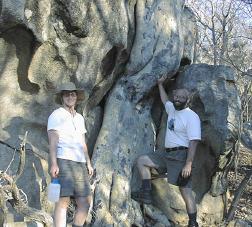 We spent much of our time hiking throughout the mysterious
and sculpted terrain of Matobo. With the rhinos scarce and hard to spot,
and no other dangerous animals in the park, one is free to wander without
fear of being stalked by lions or other man-eaters. Hiking with Tess, Patty
and Martin offered us a tremendous insight into the plants and animals of
Zimbabwe. Sharing their knowledge and their company camping was very special
for us.
We spent much of our time hiking throughout the mysterious
and sculpted terrain of Matobo. With the rhinos scarce and hard to spot,
and no other dangerous animals in the park, one is free to wander without
fear of being stalked by lions or other man-eaters. Hiking with Tess, Patty
and Martin offered us a tremendous insight into the plants and animals of
Zimbabwe. Sharing their knowledge and their company camping was very special
for us.
Before we met up with our friends at Matobo, we detoured off the short route and visited a sight south of Harare: the Serima Mission. Originally we had planned to see the mission on the trip north to Harare, but as the mission is at the end of a very long dirt road we felt that it wouldn't be wise to drive Spot there with one carburetor out. At it turns out, this dirt road is quite well groomed and in dry weather as easy to drive on as tarmac.
The mission was designed by Father Serima himself, and is filled with wood carvings depicting biblical events and characters in an African context. We were surprised at the high level of craftsmanship in both the carvings and the building itself. We didn't expect this sort of quality for a small mission built a hundred years ago in the middle of nowhere in Africa.
|
|
Hwange
November 2nd - November 5th, 1999
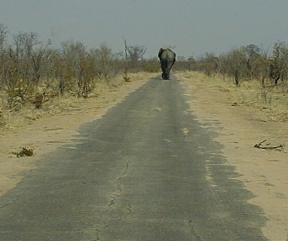
Zimbabwean weather patterns are a little unusual for an Californian. Back home winter and spring are the wet time of the year, but here they're the dry seasons. We're told that this is the best time to visit, as the weather is cool, the foliage is at its thinnest and the animals are easy to find as they must congregate at the few remaining water holes. What isn't said is that for the animals this the harshest time of the year, with both food and water scarce. It is in this context that we visit Hwange, one of the largest national parks in Zimbabwe. Despite recent rains it's bone dry here, making for dead-looking forests and animals that must forage long distances to feed themselves.
African parks we've seen so far have had an abundance of impala and other small hoofed animals that serve as food for the larger carnivores. This doesn't seem to be true here in Hwange, so the lions regularly attack giraffes and other large animals. We arrived with the rangers abuzz about the last week's giraffe kill that fed a pride of lions all week. It was easy to find as it was right next to the road, but after a week of lions, hyenas and vultures gnawing away there was little left of the giraffe but bones (below left). Further down the road right next to a group camp site situated by one of the few watering holes not dried up was this rare elephant kill (below right); the poor thing was only an adolescent. The camp site is the kind that must be rented out by a single group, and while that must make for very interesting wildlife viewing we have to admit that it would have been difficult to camp there. The smell of putrescence was overwhelming.
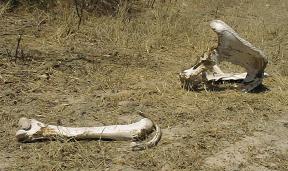 |
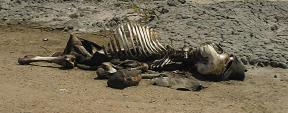 |
We especially enjoyed the Sinamatella camp site in the northwest section of the park, despite the poor roads leading there. You camp on an escarpment overlooking the plains of Hwange, and the camp's restaurant and bar are strategically situated in prime viewing areas. While we weren't terribly close to the rhinos, giraffes and other animals we saw there, the shade and cool drinks made the patience required for wild life viewing easier to come by.
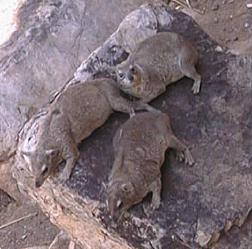 While we were able to view many of our favorite African animals,
Hwange also introduced us to a new critter we had never heard of: dassies.
We first spied them near a watering hold down the road from camp, and initially
thought they were rabbits or big squirrels. Then we saw one walk calmly
past some pedestrians, reach up on its hind legs to grab a thin, low branch
and then pull itself up and start to wander around the tree's branches with
an ease beyond that of any animal we've ever seen.
While we were able to view many of our favorite African animals,
Hwange also introduced us to a new critter we had never heard of: dassies.
We first spied them near a watering hold down the road from camp, and initially
thought they were rabbits or big squirrels. Then we saw one walk calmly
past some pedestrians, reach up on its hind legs to grab a thin, low branch
and then pull itself up and start to wander around the tree's branches with
an ease beyond that of any animal we've ever seen.
Dassies' boldness must be experienced to be believed. They have no fear of humans, and hang out like no other animal at water holes frequented by carnivores. Asking around we were amazed to find out that they've never been domesticated (no one even heard of anyone who's tried); as cute and cuddly as they look, and the lack of fear they have of man it seemed to us that they would make great pets.
Perhaps the most amazing thing we learned about dassies is that in the
animal kingdom they are most closely related to the elephant. Now, a big
dassie comes in at a quarter of a meter long and just a few kilos, but one
can understand when you look at them and they look back at you with the
same serenity as an elephant.
 At this very same water hole where we first
viewed the dassies we had the good fortune to meet and make friends with
another Bay Area resident, Sue (pictured right). Sue first fell in love
with Africa when she worked with a group to save the African rhino, and
makes frequent visits to the region. She currently works in Kazakhstan as
an on-site network guru for Chevron and gets an ungodly amount of vacation
time a year to travel and see the world. As her next stop is also Victoria
Falls, we make plans to get together for dinner.
At this very same water hole where we first
viewed the dassies we had the good fortune to meet and make friends with
another Bay Area resident, Sue (pictured right). Sue first fell in love
with Africa when she worked with a group to save the African rhino, and
makes frequent visits to the region. She currently works in Kazakhstan as
an on-site network guru for Chevron and gets an ungodly amount of vacation
time a year to travel and see the world. As her next stop is also Victoria
Falls, we make plans to get together for dinner.
Victoria Falls
November 6th - November 8th, 1999
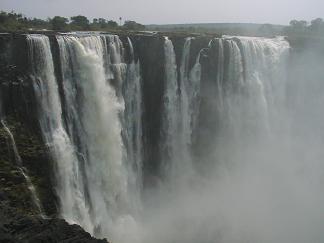
Our final stay-over in Zimbabwe is the little town of Victoria Falls near the famous waterfall of the same name. One serious tourist trap, we opted for a nice caravan park outside of town and tried to stay away from bedlam as much as possible. Only on our last day in Zimbabwe did we visit the famous falls, and found them as breath-taking as their reputation suggests. Actually a series of falls, Victoria Falls is created by a vertical-faced gorge that cuts perpendicular to the flow of the Zambezi and changes the river's nature from a fat and lazy flow to a frantic and narrow torrent.
We experienced this torrent first hand by spending a day whitewater rafting down a twenty kilometer section of the river just below the falls. As our visit comes at the end of the dry season, the river level is very low and we were surprised to learn that this is the preferred time of year for the adventure seekers to raft the river. When the river level drops, more boulders and whirlpools appear and makes the water more treacherous than usual. Many of the obstacles we passed through earn their names this time of the year; Devil's Toiletbowl, Jaws of Death and the Washing Machine were eye-catchers, but our favorite was Commercial Suicide. Our tour leaders made us carry our rafts around that one.
Despite neither of us white-water rafting a wild river before, we were pleased to have only been tossed out of our raft once, and that was when our team leader refused to back down when he and another raft leader played chicken, resulting in both boats capsizing. Most of the other hundred-odd rafting tourists weren't so fortunate; Kathy and Jim pulled a fair number of them out of the river.
|
|
The evening after white-water rafting we met up with our friend Sue for Indian food. We all wished we had met early in our trips, as we felt we would have made good four wheel driving companions. Hopefully our future travels will bring us together again.